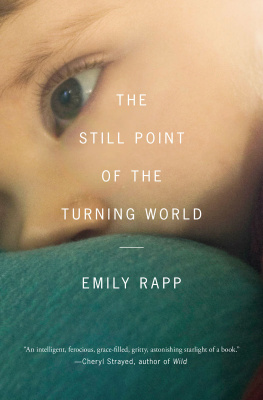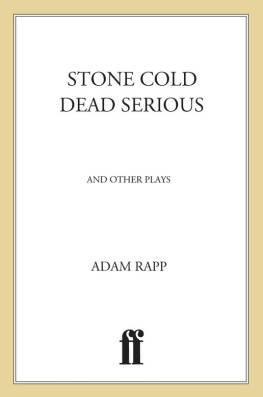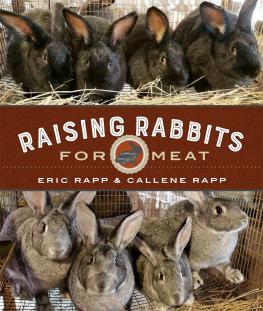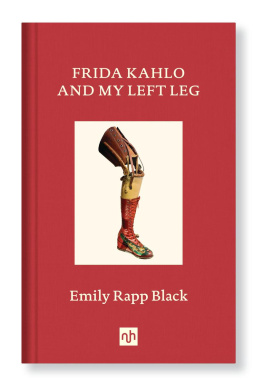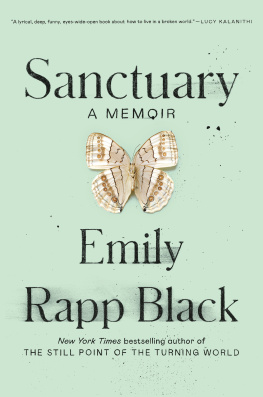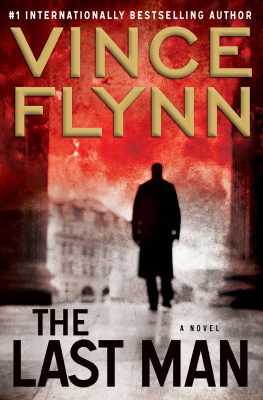ALSO BY EMILY RAPP
Poster Child
THE PENGUIN PRESS
Published by the Penguin Group
Penguin Group (USA) Inc., 375 Hudson Street, New York, New York 10014, USA Penguin Group (Canada), 90 Eglinton Avenue East, Suite 700, Toronto, Ontario M4P 2Y3, Canada (a division of Pearson Penguin Canada Inc.) Penguin Books Ltd, 80 Strand, London WC2R 0RL, England Penguin Ireland, 25 St Stephens Green, Dublin 2, Ireland (a division of Penguin Books Ltd) Penguin Group (Australia), 707 Collins Street, Melbourne, Victoria 3008, Australia (a division of Pearson Australia Group Pty Ltd) Penguin Books India Pvt Ltd, 11 Community Centre, Panchsheel Park, New Delhi110 017, India Penguin Group (NZ), 67 Apollo Drive, Rosedale, Auckland 0632, New Zealand (a division of Pearson New Zealand Ltd) Penguin Books (South Africa), Rosebank Office Park, 181 Jan Smuts Avenue, Parktown North 2193, South Africa Penguin China, B7 Jiaming Center, 27 East Third Ring Road North, Chaoyang District, Beijing 100020, China
Penguin Books Ltd, Registered Offices:
80 Strand, London WC2R 0RL, England
First published in 2013 by The Penguin Press,
a member of Penguin Group (USA) Inc.
Copyright Emily Rapp, 2013
All rights reserved
constitutes an extension of this copyright page.
LIBRARY OF CONGRESS CATALOGING IN PUBLICATION DATA
Rapp, Emily.
The still point of the turning world / Emily Rapp.
pages cm
ISBN 978-1-101-60585-1
1. Rapp, EmilyBiography. 2. Tay-Sachs diseasePatientsBiography. 3. Terminally ill childrenFamily relationshipsBiography. I. Title.
RJ399.T36R37 2013
618.92'8588450092dc23
[B]
2012039516
No part of this book may be reproduced, scanned, or distributed in any printed or electronic form without permission. Please do not participate in or encourage piracy of copyrighted materials in violation of the authors rights. Purchase only authorized editions.
Penguin is committed to publishing works of quality and integrity. In that spirit, we are proud to offer this book to our readers; however, the story, the experiences, and the words are the authors alone.
FOR RONAN, ALWAYS
I love the handful of earth you are.
Pablo Neruda, 100 Love Sonnets
Contents
T his is a love story, which, like all great love stories, is ultimately a story of loss. On January 10, 2011, my husband, Rick, and I received the worst possible news: that our son, Ronan, then nine months old, had Tay-Sachs disease, a rare, progressive and always fatal condition with no treatment and no cure.
I had been worried for some time. Ronan was experiencing developmental delays, missing important milestones. I would rush home from work each day hoping hed started to crawl or had said his first word. He was the same sweet, happy, gurgling babybut that was the problem. He was the same at nine months old as he had been at six months. Our pediatrician suggested that we rule out any vision problems, so we drove from our home in Santa Fe to the pediatric ophthalmologists office in Albuquerque.
I sat in the examination chair as the eye doctor, a short, friendly man with black glasses, played cartoons for Ronan on his iPhone and flashed a series of lights in Ronans eyes. Hes got good fixation, he said. Ronan squirmed in my lap. Great, I thought, he can see. But behind this feeling of relief was a surge of panicwhy, then, was he having these delays? I handed Ronan to Rick and sat in a chair nearby.
Let me just check his retinas, the doctor said, and hit the lights. I could see Ronans little eyes flash in the dark, and then Ricks. The doctor carefully approached Ronan and peered into his eyes using a special light.
Oh, boy, the doctor said. Oh, boy was what my father had said when the doctors told my parents about my birth defect, which resulted in the amputation of my left foot. I gripped the sides of the chair and felt the floor drop away. The doctor flipped on the lights and said, Ive only seen this one other time.
What is it? I asked, but I could see from his face that it was disastrous.
Hey, little guy, Rick said, and turned Ronan to face him.
Rick, I said. My hands were sweating, trembling. Rick!
He has cherry-red spots on the backs of his retinas, the doctor continued. Ive only seen this one other time in fifteen years of practice. Its Tay-Sachs. He paused. I am so sorry.
Whats that? Rick asked calmly, but then he quickly had to attend to me because I was wailing. I had wet my pants. The doctor calmly called for a nurse.
I was tested! I shouted. I had the test. I remembered the genetic counselor asking, Are you Jewish? and shaking my head. I want the Tay-Sachs test anyway, Id said. Or had I? Had I, in this moment, instantly generated a memory to try to mitigate the present horror?
I dont know, the doctor said uncertainly, and looked as if he might cry. I stared at him. Did I? I asked in a squeaky voice, but of course he would not know. He was the eye doctor, a man wed just met, not the person who had administered the test. He shook his head and cleared his throat. I would later learn that the standard prenatal screening for Tay-Sachs only detects the nine most common mutationsthose found among the Ashkenazi Jewish populationbut there are more than one hundred known mutations. I would have needed to ask for a combination DNA and enzyme test or requested that my DNA be sequenced. I had not known to ask for either of these. I was told the odds of my being a carrier were astronomical, and both parents must be carriers for a child to inherit Tay-Sachs. Rick is Jewish, but by testing one of us, we thought we were covering our bases.
My mom, my mom, I said to Rick, gripping his arm and then taking Ronan from him. I clutched at my son, running my shaking hands over his head, his arms, his fat legs. Little guy, little guy, I said. He squirmed and giggled. I had the urge to swallow him, to try to return him to my body, where hed be safe, but of course hed never been safe, not even there. Wheres my mom? I was shouting now. I need to call my mom. Wheres the phone? Give me the phone.
Well, what can we do about it? Rick asked, glancing between me and Ronan and the doctor, digging in the diaper bag for the cell phone, but I knew enough about Tay-Sachs to know that there was nothing at all for us to do and that my life, the life as a new and hopeful mother, was over.
The doctor looked at the two of us. No, Im so sorry, he said. Theres no way to fix it.
They die, I stuttered. I had the sensation of skin falling away from bone. I hugged Ronan more tightly. They. Die. I wanted to vomit, and my grip on Ronan was scaring him. I loosened my arms slightly.
What? Rick asked. Surely
They die, I said firmly in a high-pitched voice, and this time he understood that I meant Ronan, that Ronanour boy, our baby, our childwould die. The world was broken, and the three of usRonan, Rick and Iwere falling into its mouth
Nerve damage begins in the womb and progresses quickly, leading to dementia, decreased interaction with the environment, seizures, spasticity, and eventuallydeath. Paralysis, blindness, deafness, loss of all faculties. The doctor showed us a laminated medical photograph of normal retinas, and then another set with red spots drawn in the center of diseased retinas, ruined eyes. Another doctor checked Ronans eyes again, stoically, to confirm the diagnosis. Yes, Id agree that its Tay-Sachs, he said, and quickly left the room.

